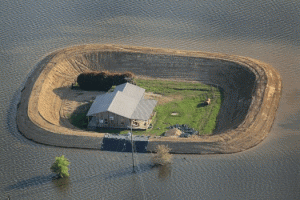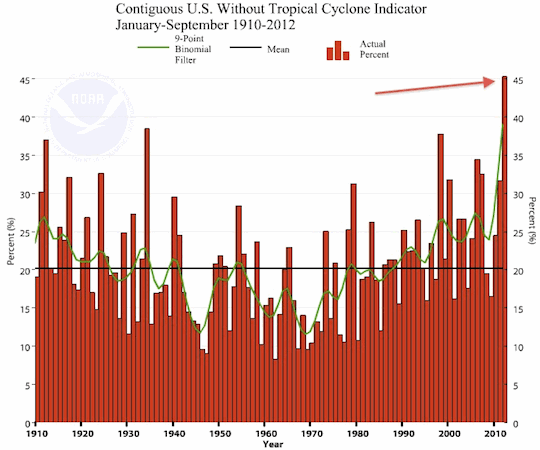NOAA Bombshell: Warming-Driven Arctic Ice Loss Is Boosting Chance of Extreme U.S. Weather
 Two new studies make a strong case that global warming is driving an intensification of high-pressure anomalies that in turn make North American weather more extreme. They add to a growing body of scientific observation and analysis on the connection between man-made climate change and extreme weather — and disasters.
Two new studies make a strong case that global warming is driving an intensification of high-pressure anomalies that in turn make North American weather more extreme. They add to a growing body of scientific observation and analysis on the connection between man-made climate change and extreme weather — and disasters.So I can say, not coincidentally, Munich Re, the world’s largest reinsurance company is releasing a report next week based on its natural catastrophe database — the most comprehensive of its kind in the world — that concludes:
•Global warming is driving an increase in weather-related disasters
•”North America is the continent with the largest increases in disasters.”
And so I can also say, not coincidentally, NOAA’s National Climatic Data Center (NCDC) reported Tuesday in its “State of the Climate” for September that the Climate Extremes Index for the period January-through-September was over the highest ever — and over twice the average value — since record-keeping began in 1910.

NOAA’s Climate Extremes Index (year-tod-date) is at the highest level ever.
We appear to have a perfect storm: Detailed observations of more extreme weather in North America in recent years are now coming at the same time as new scientific analyses that can explain why manmade climate change is boosting extreme weather in our continent.
The two new studies are “The recent shift in early summer Arctic atmospheric circulation” (subs. req’d, news release here) and “Intensification of Northern Hemisphere subtropical highs in a warming climate” (subs. req’d, news release here). The latter Nature Geoscience study is closely related to a 2010 Journal of Climate study that found “global warming is the main cause of a significant intensification in the North Atlantic Subtropical High (NASH) that in recent decades has more than doubled the frequency of abnormally wet or dry summer weather in the southeastern United States.”
The first study is related to another 2012 Geophysical Research Letters study, “Evidence linking Arctic amplification to extreme weather in mid-latitudes,” which found that the loss of Arctic ice favors “extreme weather events that result from prolonged conditions, such as drought, flooding, cold spells, and heat waves.”
What makes this study a bombshell is that it is led by our very own National Oceanic and Atmospheric Administration (aka NOAA), which put out a news release explaining how global warming drives extreme weather in North America:
“Our research reveals a change in the summer Arctic wind pattern over the past six years. This shift demonstrates a physical connection between reduced Arctic sea ice in the summer, loss of Greenland ice, and potentially, weather in North American and Europe,” said [NOAA’s James] Overland, an oceanographer who leads the laboratory’s Coastal and Arctic Research Division.
The shift provides additional evidence that changes in the Arctic are not only directly because of global warming, as shown by warmer air and sea temperatures, but are also part of an “Arctic amplification” through which multiple Arctic-specific physical processes interact to accelerate temperature change, ice variability, and ecological impacts.
The NOAA release explains:
“Higher pressure over the North American continent and Greenland is driving these changes in the early summer wind patterns,” said Edward Hanna, Ph.D, of the University of Sheffield.
These shifts in winds not only affect weather patterns throughout the Arctic but are also thought to influence weather in Greenland, the United States, and western Europe. Understanding such links is an ongoing area of research, the scientists said. The effects of Arctic amplification will increase as more summer ice retreats over coming decades. Enhanced warming of the Arctic affects the jet stream by slowing its west-to-east winds and by promoting larger north-south meanders in the flow. Predicting those meanders and where the weather associated with them will be located in any given year, however, remains a challenge.
The researchers say that with more solar energy going into the Arctic Ocean because of lost ice, there is reason to expect more extreme weather events, such as heavy snowfall, heat waves, and flooding in North America and Europe but these will vary in location, intensity, and timescales.
“What we’re seeing is stark evidence that the gradual temperature increase is not the important story related to climate change; it’s the rapid regional changes and increased frequency of extreme weather that global warming is causing. As the Arctic warms at twice the global rate, we expect an increased probability of extreme weather events across the temperate latitudes of the northern hemisphere, where billions of people live,” said Jennifer Francis, Ph.D, of Rutgers.

Arctic Sea Ice is melting much, much faster than even the best climate models had projected. The reason is most likely unmodeled amplifying feedbacks.
What’s fascinating about Hanna’s statement that “higher pressure over the North American continent and Greenland is driving these changes in the early summer wind patterns,” is how it might connect to the second study.
High-pressure systems over oceans, which largely determine the tracks of tropical cyclones and hydrological extremes in much of the northern hemisphere, are likely to intensify this century, according to a Duke University-led study published online this week in Nature Geoscience.
The study’s findings suggest that as summertime near-surface high-pressure systems over the northern Pacific and Atlantic oceans strengthen, they could play an increasingly important role in shaping regional climate, particularly the occurrence of drought and extreme summer rainfall, in coming years….
According to the simulations, these high-pressure systems will intensify over the 21st century as a result of increasing greenhouse-gas concentrations. The simulations suggest that an increase in the land-sea thermal contrast – the difference between ocean and land heating, as Earth’s climate warms – will fuel the systems’ intensification.
For more on this study, see Climate Central’s piece, “Global Warming May Shift Summer Weather Patterns.” They quote study coauthor Mingfang Ting of Columbia University, “The intensification and westward movement of the subtropical highs may cause more landfalling hurricanes/typhoons and cause more intense Southeast U.S. rainfall variability, leading to more extreme events in the[se] regions.” They also noted, “Recent summers have seen dramatic flips between punishing droughts and severe flooding in states such as Georgia, for example.”
THE BOTTOM LINE: We are playing with the climate system in ways that are already starting to bite us and may until consume us — our at least our food supply — whole!
You can return to the main Market News page, or press the Back button on your browser.

